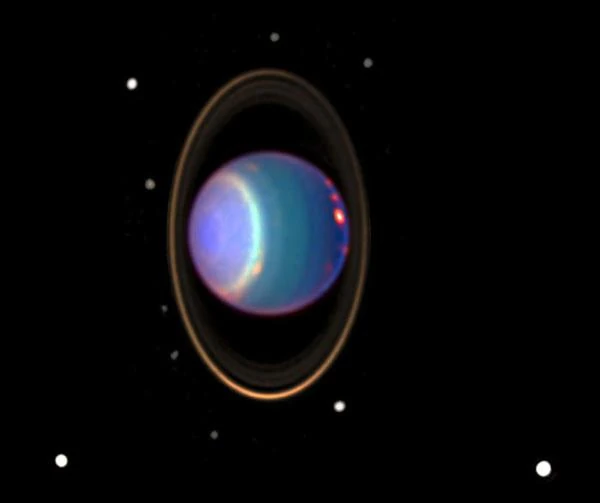
Image: Most planets rotate on an axis almost perpendicular to the ecliptic plane, but Uranus' axis is almost parallel to this plane. Uranus seems to 'roll' in its orbit. Uranus has thin rings with sharp edges like other gas giants, they are very dark like those of Jupiter and composed of relatively large particles up to 20 meters in diameter. There are 13 main rings, all opaque and a few km wide. The brightest being the Epsilon ring. Image credit NASA). We can see on this image, 10 moons of Uranus.
Uranus is the seventh planet from the Sun and is considered an ice giant planet due to its composition consisting mainly of water, ammonia and methane in the form of ice.
• Size and mass: Uranus has a mass of about 8.68 x 10^25 kg, which is about 14.5 times that of Earth. Its size is also remarkable, with a diameter of 50,724 km, or about 4 times that of the Earth.
• Atmosphere: The atmosphere of Uranus is mainly composed of hydrogen (about 83%) and helium (about 15%), with traces of methane, ammonia and water. The presence of methane in Uranus' atmosphere gives the planet a distinct blue color
• Axis tilt: Uranus is unique in the solar system because it has an axial tilt of nearly 98 degrees, which means the planet is sort of "lying" on its side. This extreme tilt is likely due to a collision with an Earth-sized celestial body during the planet's history.
• Rings: Uranus has a tenuous and unspectacular ring system, similar in characteristics to Jupiter and Saturn.
• Magnetosphere: Uranus has a relatively weak magnetic field, but it is tilted relative to the planet's axis of rotation. This tilt gives rise to a complex magnetosphere that changes over time.
• Satellites: Uranus has at least 27 known natural satellites, of which
• Orbit: Uranus orbits the Sun at an average distance of about 2.9 billion km, or about 19.2 astronomical units.
• Internal composition: The internal composition of Uranus is mainly water, ammonia and methane in the form of ice, with a rocky and metallic core. The pressure and temperature inside the planet are high enough for these substances to be compressed into a liquid metallic form.
Uranus is unique in the solar system because the inclination of its axis of rotation is about 98°, that is to say that it is practically lying on the plane of revolution around the Sun. The geographic poles face the Sun while on the other planets they are perpendicular to the plane of rotation. Learn more.
Definition of the word planet (August 24, 2006):
"A planet is a celestial body which is in orbit around the Sun, which has sufficient mass so that its gravity overcomes the cohesive forces of the solid body and maintains it in hydrostatic equilibrium (spherical shape), and which has eliminated any body moving in a near orbit".